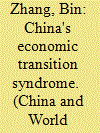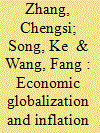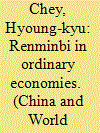|
|
|
Sort Order |
|
|
|
Items / Page
|
|
|
|
|
|
|
| Srl | Item |
| 1 |
ID:
138900


|
|
|
|
|
| Summary/Abstract |
Following 30 years of high economic growth, China's economy is in the midst of a classic transition from an industrial to a post-industrial economy. In this transition period, the mismatch between supply and demand is growing, while the country's economic growth engine is weakening. Stimulus policies have aimed to maintain the country's economic growth momentum but they have come at the price of sharply increased financial fragility and resource misallocation, both of which are harmful to economic growth. China's “economic transition syndrome” refers to the vicious cycle of slowing GDP growth, combined with increasing demand for stimulus policies, and increasing financial fragility and resource misallocation.
|
|
|
|
|
|
|
|
|
|
|
|
|
|
|
|
| 2 |
ID:
138902


|
|
|
|
|
| Summary/Abstract |
The present paper studies China's national level currency exposure since 2005 when the country adopted a new exchange rate regime allowing the renminbi (RMB) to move towards greater flexibility. Using generalized autoregressive conditional heteroskedastic and constant conditional correlation-generalized autoregressive conditional heteroskedastic methods to estimate the augmented capital asset pricing models with orthogonalized stock returns, we find that China equity indexes are significantly exposed to exchange rate movements. In a static setting, there is strong sensitivity of stock returns to movements of China's tradeweighted exchange rate, and to the bilateral exchange rates except the RMB/dollar rate. However, in a dynamic framework, exposure to all the bilateral currency pairs under examination is significant. The results indicate that under the new exchange rate regime, China's gradualist approach to moving towards greater exchange rate flexibility has managed to keep exposure to a moderate level. However, we find evidence that in a dynamic setting, the exposure of the RMB to the dollar and other major currencies is significant. For China, the challenge of managing currency risk exposure is looming greater.
|
|
|
|
|
|
|
|
|
|
|
|
|
|
|
|
| 3 |
ID:
138898


|
|
|
|
|
| Summary/Abstract |
Foreign direct investment (FDI) in China is heavily concentrated in the coastal regions. Do inland provinces benefit from coastal FDI? We use a provincial-level panel dataset and employ the fixed-effects instrumental variables regression technique to investigate the interregional spillovers from coastal FDI to inland provinces. The study finds that, on average, coastal FDI has a negative impact on the economic growth of inland provinces. In addition, depending on the different trade activities engaged in (i.e. whether processing trade or ordinary trade), coastal FDI has different impacts on the economic growth of inland provinces.
|
|
|
|
|
|
|
|
|
|
|
|
|
|
|
|
| 4 |
ID:
138901


|
|
|
|
|
| Summary/Abstract |
This paper evaluates whether globalization has increased the role of global factors in driving inflation in China. Unlike other published studies on the relationship between globalization and inflation, which mostly use Phillips curve models, this paper uses multivariate dynamic models to examine the dynamic interactions between globalization and inflation in China. Empirical results with quarterly data spanning from 1995 to 2012 show that the global output gap significantly affects the dynamics of inflation in China. In particular, the global output gap is superior to the domestic output gap in predicting domestic inflation. Impulse response and variance decomposition analyses reinforce this finding. Our results indicate that the central bank of China should take developments in global output into account in its monetary policy-making process.
|
|
|
|
|
|
|
|
|
|
|
|
|
|
|
|
| 5 |
ID:
138899


|
|
|
|
|
| Summary/Abstract |
China has witnessed an unprecedented great leap forward in investment since the 2008 global financial crisis, and at the same time real GDP growth has undergone a significant slowdown. This paper examines China's growth slowdown since 2008 up to 2013 using a growth accounting model in a systematic way. It is found that China's growth slowdown since 2008 almost completely comes from a sharp slowdown in total factor productivity growth. During this period, the positive effect on growth from expanding investment has been completely offset by the negative effect of the slowdown in total factor productivity growth. Currently, China's economy has slid into the Solow downward path. Under these circumstances, a soft landing is completely infeasible. Unless the Chinese Government implements substantial rebalancing and comprehensive and in-depth market-oriented reform, accompanied by large-scale de-investment (decreasing in the ratio of investment in GDP) and massive employment adjustment, China will be unable to avoid the Solow downward path, and a hard landing in investment will be inevitable in the near future.
|
|
|
|
|
|
|
|
|
|
|
|
|
|
|
|
| 6 |
ID:
138903


|
|
|
|
|
| Summary/Abstract |
In this paper, we developed the recursive unit root tests proposed by Phillips et al. (2013) and used them to identify the beginning and the end of potential excess liquidity in the Chinese monetary market during the period from 1992 to 2013. The result indicates that excess liquidity existed from the third quarter of 2002 to 2013. The analysis shows that since 2003, the inflationary pressure of excess liquidity has remained high. We provide evidence supporting the money illusion hypothesis in China. The recursive unit root test is suited to practical implementation with time series and delivers a consistent date-stamping strategy for determining the origination and termination of multiple bubbles. Simulations show that the test significantly improves discriminatory power and leads to distinct power gains.
|
|
|
|
|
|
|
|
|
|
|
|
|
|
|
|
| 7 |
ID:
138897


|
|
|
|
|
| Summary/Abstract |
Most studies of renminbi internationalization focus on the supply side, by examining China's own economic and political conditions. In contrast, this study addresses the demand side of renminbi internationalization, by providing an in-depth analysis of renminbi use in ordinary foreign economies from both economic and political perspectives, with a particular focus on South Korea, China's next-door neighbor. The study finds that sustainable indigenous market forces facilitating renminbi use in South Korea remain weak, despite the country's close economic ties with China. This research also shows, however, that the Korean Government has itself recently been able, through its policy measures, to generate new domestic support for greater use of the renminbi. These findings ultimately highlight the significant impact on the internationalization of a currency of the politics in the foreign countries using it.
|
|
|
|
|
|
|
|
|
|
|
|
|
|
|
|
|
|
|
|
|